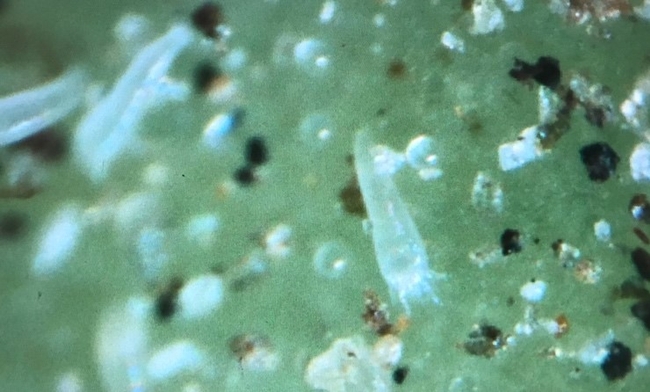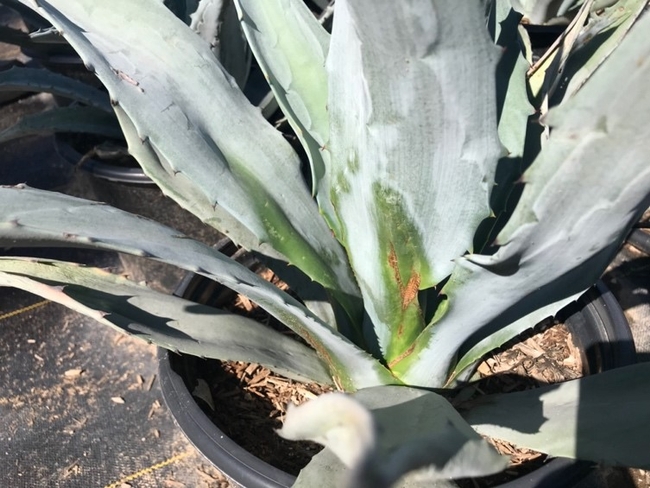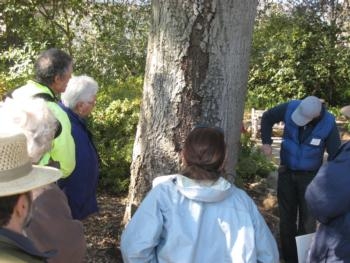
Posts Tagged: mites
Agave Mite
Implications for tequila growers
Agave are a common sight in Southern California and are frequently used in landscaping for homes, businesses, and in public spaces. You've almost certainly seen agave growing in your neighborhood and may even have some growing yourself. Many varieties of agave are grown in San Diego nurseries to keep pace with the demand for these plants across the state and country. As the climate continues to warm and California becomes increasingly dry, hardy and water-conscious plants like agave will more frequently be used in xeriscaping and as ornamentals. However, there is an almost invisible enemy that threatens many of these agave plants. Greasy streaks and smudges appear on leaves, followed by lesions and plant decline. Sometimes, the entire core of the agave collapses. The plants look sickly and unattractive, dismaying homeowners and nursery growers alike. What is causing this damage? Mites.
Agave mites are a difficult pest to manage and can be a serious problem on multiple types of agave. Being proactive and removing infected plants is currently the best way to protect your agave from mite infestations. Recognizing agave mite symptoms and being ruthless with eliminating plants is key to preventing damage. Research on management options is just beginning and there are still many unknowns, so please contact us if you are having issues with agave mites at your nursery, if you have questions, or if you think there is something we should know about. Stayed tuned for future results and hopefully some better news on how to manage this tiny menace!

agave mite damagwe
The Skinny on Avocado Pests and Diseases
Anthracnose, Sunblotch, and Armillaria Root Rot
Avocado Trunk Canker and Collar Rot
Avocado Branch Canker (Botryosphaeria)
Phytophthora Root Rot of Avocado and Management Strategies

field id
Biocontrol on Farm and at Home
|
RECOGNIZING NATURAL ENEMIES Proper identification of pests, and distinguishing pests from natural enemies, is essential for effective biological control. Carefully observe the mites and insects on your plants to help discern their activity. For example, some people may mistake syrphid fly larvae for caterpillars. However, syrphid fly larvae are found feeding on aphids and not chewing on the plant itself. If you find mites on your plants, observe them with a good hand lens. Predaceous mites appear more active than plant-feeding species. In comparison with pest mites, predaceous mites are often larger and do not occur in large groups. Consult publications listed in the References to learn more about the specific pests and their natural enemies in your gardens and landscapes. Take unfamiliar organisms you find to your local University of California (UC) Cooperative Extension office, UC Master Gardener Program, or agricultural commissioner office in your county for aid in identification. CONSERVATION: PROTECT NATURAL ENEMIES Preserve existing natural enemies by choosing cultural, mechanical, or selective chemical controls that do not harm beneficial species. Remember, only about 1% of all insects and mites are harmful. Most pests are attacked by multiple species of natural enemies (Table 1), and their conservation is the primary way to successfully use biological control. Judicious (e.g., selective, timing) pesticide use, ant control, and habitat manipulation are key conservation strategies. Ant Control and Honeydew Producers The Argentine ant and certain other ant species are considered pests primarily because they feed on honeydew produced by insects that suck phloem sap, such as aphids, mealybugs, soft scales, psyllids, and whiteflies. Ants protect honeydew producers from predators and parasites that might otherwise control them. Ants sometimes move these honeydew-producing insects from plant to plant (called “farming”). Where natural enemies are present, if ants are controlled, populations of many pests will gradually (over several generations of pests) be reduced as natural enemies become more abundant. Control methods include cultivating soil around ant nests, encircling trunks with ant barriers of sticky material, and applying insecticide baits near plants. See Pest Notes: Ants for more information. Mark Hoddle at UC Riverside is working on a gel formulation to attract ants selectively for their control: http://biocontrol.ucr.edu/hoddle/. Habitat Manipulation Plant a variety of species that flower at different times to provide natural enemies with nectar, pollen, and shelter throughout the growing season. The adult stage of many insects with predaceous larvae (such as green lacewings and syrphid flies) and many adult parasites feed only on pollen and nectar. Even if pests are abundant for the predaceous and parasitic stages, many beneficials will do poorly unless flowering and nectar-producing plants are available to supplement their diet. To retain predators and parasites, grow diverse plant species well adapted to the local conditions and that tolerate low populations of plant-feeding insects and mites so that some food is always available. Other cultural controls that can help natural enemies include reducing dust and properly fertilizing and irrigating. Dust can interfere with natural enemies and may cause outbreaks of pests such as spider mites. Reduce dust by planting ground covers and windbreaks and hosing off small plants that become excessively covered with dust. Avoid excess fertilization and irrigation, which can cause phloem-feeding pests, such as aphids, to reproduce more rapidly than natural enemies can provide control. REFERENCES Dreistadt, S.H., M.L. Flint, and J.K. Clark. 2004. Pests of Landscape Trees and Shrubs: An Integrated Pest Management Guide. 2nd ed. Oakland: Univ. Calif. Agric. Nat. Res. Publ. 3359. Flint, M.L. and S.H. Dreistadt. 1998. Natural Enemies Handbook: The Illustrated Guide to Biological Pest Control. Oakland: Univ. Calif. Div. Agric. Nat. Res. Publ. 3386. Rust, M.K. and D.-H. Choe. 2012. Pest Notes: Ants. Oakland: Univ. Calif. Agric. Nat. Res. Publ. 7411.
|
||||||
|
: |
NATURAL ENEMIES |
|||||
|
PESTS |
Lacewings |
Lady beetles |
Parasitic flies |
Parasitic wasps |
Predatory mites |
Other Groups and Examples |
|
aphids |
X |
X |
|
X |
|
entomopathogenic fungi, soldier beetles, syrphid fly larvae |
|
carpenterworm, clearwing moth larvae |
|
|
|
X |
|
entomopathogenic nematodes |
|
caterpillars (e.g., California oakworm) |
X |
|
X |
X |
|
Bacillus thuringiensis, birds, entomopathogenic fungi and viruses, predaceous bugs and wasps,Trichogramma spp. (egg parasitic wasps), spiders |
|
cottony cushion scale |
|
X |
X |
|
|
Cryptochaetum iceryae (parasitic fly), vedalia beetle |
|
elm leaf beetle |
|
|
X |
X |
|
Erynniopsis antennata (parasitic fly),Oomyzus (=Tetrastichus) spp. (parasitic wasps) |
|
eucalyptus longhorned borers |
|
|
|
X |
|
Avetianella longoi (egg parasitic wasp) |
|
eucalyptus redgum lerp psyllid |
|
|
|
X |
|
Psyllaephagus bliteus (parasitic wasp) |
|
giant whitefly |
X |
X |
|
X |
|
Encarsia hispida, Encarsia noyesi, Entedononecremnus krauteri, andIdioporus affinis (parasitic wasp), syrphid fly larvae |
|
glassy-winged sharpshooter |
X |
|
|
X |
|
assassin bugs, Gonatocerus spp. (egg parasitic wasps), spiders |
|
lace bugs |
X |
X |
|
X |
|
assassin bugs and pirate bugs, spiders |
|
mealybugs |
X |
X |
|
X |
|
mealybug destroyer lady beetle |
|
mosquitoes |
|
|
|
|
|
Bacillus thuringiensis spp. israelensis, mosquito-eating fish |
|
psyllids |
X |
X |
|
X |
|
pirate bugs |
|
scales |
X |
X |
|
X |
X |
Aphytis, Coccophagus, Encarsia, andMetaphycus spp. parasitic wasps |
|
slugs, snails |
|
|
X |
|
|
Rumina decollata (predatory snail), predaceous ground beetles, birds, snakes, toads, and other vertebrates |
|
spider mites |
X |
X |
|
|
X |
bigeyed bugs and minute pirate bugs,Feltiella spp. (predatory cecidomyiid fly larvae), sixspotted thrips, Stethorus picipes (spider mite destroyer lady beetle), predatory mites |
|
thrips |
X |
|
|
X |
X |
minute pirate bugs, predatory thrips |
|
weevils, root or soil-dwelling |
|
|
|
X |
|
Steinernema carpocapsae andHeterorhabditis bacteriophora(entomopathogenic nematodes) |
|
whiteflies |
X |
X |
|
X |
|
bigeyed bugs and minute pirate bugs,Cales, Encarsia, and Eretmocerus spp. parasitic wasps, spiders |
Predatory mite going after citrus red mite

predatory mite
Biocontrol and Timing of Augmentative Releases
TYPES OF NATURAL ENEMIES
Parasites, pathogens, and predators are the primary groups used in biological control of insects and mites (Table 1). Most parasites and pathogens, and many predators, are highly specialized and attack a limited number of closely related pest species. Learn how to recognize natural enemies by consulting resources such as the Natural Enemies Handbook and the Natural Enemies Gallery.
Parasites
A parasite is an organism that lives and feeds in or on a host. Insect parasites can develop on the inside or outside of the host's body. Often only the immature stage of the parasite feeds on the host. However, adult females of certain parasites (such as many wasps that attack scales and whiteflies) feed on and kill their hosts, providing an easily overlooked but important source of biological control in addition to the host mortality caused by parasitism.
Although the term “parasite” is used here, true parasites (e.g., fleas and ticks) do not typically kill their hosts. Species useful in biological control, and discussed here, kill their hosts; they are more precisely called “parasitoids.”
Most parasitic insects are either flies (Order Diptera) or wasps (Order Hymenoptera). Parasitic wasps occur in over three dozen Hymenoptera families. For example, Aphidiinae (a subfamily of Braconidae) attack aphids. Trichogrammatidae parasitize insect eggs. Aphelinidae, Encyrtidae, Eulophidae, and Ichneumonidae are other groups that parasitize insect pests. It's important to note that these tiny to medium-sized wasps are incapable of stinging people. The most common parasitic flies are the typically hairy Tachinidae. Adult tachinids often resemble house flies. Their larvae are maggots that feed inside the host.
Pathogens
Natural enemy pathogens are microorganisms including certain bacteria, fungi, nematodes, protozoa, and viruses that can infect and kill the host. Populations of some aphids, caterpillars, mites, and other invertebrates are sometimes drastically reduced by naturally occurring pathogens, usually under conditions such as prolonged high humidity or dense pest populations. In addition to a naturally occurring disease outbreak (epizootic), some beneficial pathogens are commercially available as biological or microbial pesticides. These include Bacillus thuringiensis or Bt, entomopathogenic nematodes, and granulosis viruses. Additionally, some microorganism by-products, such as avermectins and spinosyns are used in certain insecticides; but applying these products is not considered to be biological control.
Predators
Predators kill and feed on several to many individual prey during their lifetimes. Many species of amphibians, birds, mammals, and reptiles prey extensively on insects. Predatory beetles, flies, lacewings, true bugs (Order Hemiptera), and wasps feed on various pest insects or mites. Most spiders feed entirely on insects. Predatory mites that feed primarily on pest spider mites include Amblyseius spp., Neoseiulus spp., and the western predatory mite, Galendromus occidentalis.
AUGMENTATION
When resident natural enemies are insufficient, their populations can sometimes be increased (augmented) through the purchase and release of commercially available beneficial species. However, there has been relatively little research on releasing natural enemies in gardens and landscapes. Releases are unlikely to provide satisfactory pest control in most situations. Some marketed natural enemies are not effective. Many natural enemies are generalist predators and are cannibalistic and feed indiscriminately on pest and beneficial species, thereby reducing their effectiveness.
Only a few natural enemies can be effectively augmented in gardens and landscapes. For example, entomopathogenic nematodes can be applied to control certain tree-boring and lawn-feeding insects. Convergent lady beetles (Hippodamia convergens) purchased in bulk through mail order, stored in a refrigerator, and released in very large numbers at intervals can temporarily control aphids; however, lady beetles purchased through retail outlets are unlikely to be sufficient in numbers and quality to provide control.
Successful augmentation generally requires advanced planning, biological expertise, careful monitoring, optimal release timing, patience, and situations where certain levels of pests and damage can be tolerated. Situations where pests or damage are already abundant are not good opportunities for augmentation.
A classic example of poor timing for augmentative release of predatory mites for control of broad mite in coastal lemon or persea mite in avocado is right now. Pest populations for the most part have soared and releasing predatory mites is little help. Predatory mites need to be releases into a small growing population, so in both of these cases it would have been better to start small, frequent releases early and throughout the spring to knock their populations back.
Adult predatory mite, Euseius tularensis, and citrus red mite.

predatory mite
13th Annual Strawberry Production Meeting in August

Join Ventura County strawberry growers at the 13th Annual Strawberry Production Meeting!
Strawberries are the largest crop grown in Ventura County and represent millions in revenues to the area. UC Ventura County Cooperative Extension advisor Dr. Oleg Daugovish sponsors this event every year to update the public and county growers on the latest in strawberry research. The meeting will feature agricultural experts who will speak on topics relevant to strawberry production in Ventura County. Several presentations will focus on irrigation, an important issue for growers in drought-susceptible southern California.
Time: 7:30 (registration); 8:00 am to 12:30 pm
Location:
Freedom Center
516 Eubanks Rd.
Camarillo, CA
Event is free, no cost to public and includes lunch and refreshments.
In English and in Spanish
Contact Oleg Daugovish at 805-645-1454 or odaugovish@ucdavis.edu for registration or to make special arrangements.
See here to view flyer/agenda for this event!
Continuous education credits have been approved from the Department of Pesticide Regulation and VCAILG credits have been requested from the Regional Water Quality Control Board.
